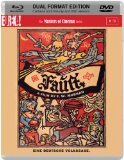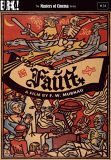 FAUST (Masters of Cinema) (DVD & BLU-RAY DUAL FORMAT) | Blu Ray | (18/08/2014)
from £13.35
| Saving you £6.64 (49.74%)
| RRP
FAUST (Masters of Cinema) (DVD & BLU-RAY DUAL FORMAT) | Blu Ray | (18/08/2014)
from £13.35
| Saving you £6.64 (49.74%)
| RRP Shot in the UFA studios with a big movie star in the lead and all the special effects and production design resources any blockbuster of its time could wish for, FW Murnau's 1926 Faust represents a step up from his better-known Nosferatu. Oddly, Faust is a less familiar film than the vampire quickie and this release affords fans a chance to see what Murnau can do with an equally major fantasy story. Adapted neither from Marlowe's play Dr Faustus nor Goethe's verse drama, the script scrambles various elements of the legend and presents a Faust (Gosta Ekman) driven to summon the Devil by despair as a plague rages through the town, desperate to gain enough learning to help his neighbours. When this deal doesn't quite work out, because he is stoned by townsfolk who notice his sudden fear of the cross, Mephisto (Emil Jannings) offers Faust instead renewed youth and an opportunity to seduce a famously beautiful Italian noblewoman and then to return to his home village and get involved with the pure Gretchen (Camilla Horn). Like most versions of the story, it's episodic and some sections are stronger than others: the great stuff comes in the plague and initial deal sequences, though it picks up again for the tragic climax as Gretchen becomes the central figure and suffers horribly, freezing in the snows and burning at the stake. Jannings' devil, a gruesomely humorous slice of ham, is one of the great silent monster performances, reducing everyone else to a stick figure, and Murnau faces the challenge of topping his Nosferatu imagery by deploying a battalion of effects techniques to depict the many magical journeys, sudden appearances and transformations. On the DVD: Often seen in ragged, incomplete prints projected at the wrong speed, this is a decently restored version, running a full 115 minutes with a complete orchestral score. The original materials show some of the damage to be expected in a film of its vintage, but the transfer is excellent, displaying the imaginative art direction and camerawork to superb advantage. Aside from a nicely eerie menu, the sole extra is a full-length commentary originating in Australia: written by historian Peter Spooner but read by narrator Russell Cawthorne (who mispronounces the odd name). This provides an interesting wealth of background detail, such as Murnau's attempt to cast Hollywood's Lillian Gish as Gretchen, and delivers a balanced assessment of the film itself. --Kim Newman
 Faust | DVD | (26/06/2006)
from £N/A
| Saving you £N/A (N/A%)
| RRP
Faust | DVD | (26/06/2006)
from £N/A
| Saving you £N/A (N/A%)
| RRP Murnau's last German film features astonishing photography magnificent art direction and special effects which retain the power to amaze. Freed from the constraints of psychological narrative Murnau's mastery of cinematic technique places Faust at the pinnacle of the silent era its barrage of visceral and apocryphal imagery contrasting with the simplicity and directness of its spiritual theme. Faust's tale is a classic one of a man who sells his soul to the devil. In an attempt
![L'Argent [1928] [Masters of Cinema]](/pictures/1088502.jpg) L'Argent | DVD | (24/11/2008)
from £N/A
| Saving you £N/A (N/A%)
| RRP
L'Argent | DVD | (24/11/2008)
from £N/A
| Saving you £N/A (N/A%)
| RRP Adapted from ''‰mile Zola's novel of the same name Marcel L'Herbier's L'Argent [Money] is an opulent classic of late-silent era cinema. Filmed in part on location at the Paris stock exchange it reveals a world of intrigue greed decadence and ultimately corruption and scandal when business dealings and amorous deceit combine. Business tycoons Saccard and Gunderman lock horns when the former attempts to raise capital for his faltering bank. To inflate the price of his stock Saccard concocts a duplicitous publicity stunt involving the unwitting aviator Hamelin and a flight across the Atlantic to drill for oil much to the dismay of his wife Line. While Hamelin is away the lascivious Saccard attempts to seduce Line whose own temptation by the allure of money puts herself and her husband in danger - pawns in a high-stakes chess game played out by unscrupulous speculators. With an all-star cast (Brigitte Helm and Alfred Abel fresh from Fritz Lang's Metropolis alongside Pierre Alcover Yvette Guilbert and luminary of the French avantgarde Antonin Artaud) and a mammoth budget L'Argent is comparable in period and scale with other celebrated epics of the silent era such as Abel Gance's Napol''on. With its use of portable cameras that literally descend into the Bourse and revolve around its lavish contours L'Argent represents a type of cinematic Impressionism distinctive to the silent art - a poetry that would change forever with the coming of sound.
![Faust [1926]](/pictures/1012911.jpg) Faust | DVD | (21/01/2002)
from £19.60
| Saving you £0.39 (1.99%)
| RRP
Faust | DVD | (21/01/2002)
from £19.60
| Saving you £0.39 (1.99%)
| RRP Shot in the UFA studios with a big movie star in the lead and all the special effects and production design resources any blockbuster of its time could wish for, FW Murnau's 1926 Faust represents a step up from his better-known Nosferatu. Oddly, Faust is a less familiar film than the vampire quickie and this release affords fans a chance to see what Murnau can do with an equally major fantasy story. Adapted neither from Marlowe's play Dr Faustus nor Goethe's verse drama, the script scrambles various elements of the legend and presents a Faust (Gosta Ekman) driven to summon the Devil by despair as a plague rages through the town, desperate to gain enough learning to help his neighbours. When this deal doesn't quite work out, because he is stoned by townsfolk who notice his sudden fear of the cross, Mephisto (Emil Jannings) offers Faust instead renewed youth and an opportunity to seduce a famously beautiful Italian noblewoman and then to return to his home village and get involved with the pure Gretchen (Camilla Horn). Like most versions of the story, it's episodic and some sections are stronger than others: the great stuff comes in the plague and initial deal sequences, though it picks up again for the tragic climax as Gretchen becomes the central figure and suffers horribly, freezing in the snows and burning at the stake. Jannings' devil, a gruesomely humorous slice of ham, is one of the great silent monster performances, reducing everyone else to a stick figure, and Murnau faces the challenge of topping his Nosferatu imagery by deploying a battalion of effects techniques to depict the many magical journeys, sudden appearances and transformations. On the DVD: Often seen in ragged, incomplete prints projected at the wrong speed, this is a decently restored version, running a full 115 minutes with a complete orchestral score. The original materials show some of the damage to be expected in a film of its vintage, but the transfer is excellent, displaying the imaginative art direction and camerawork to superb advantage. Aside from a nicely eerie menu, the sole extra is a full-length commentary originating in Australia: written by historian Peter Spooner but read by narrator Russell Cawthorne (who mispronounces the odd name). This provides an interesting wealth of background detail, such as Murnau's attempt to cast Hollywood's Lillian Gish as Gretchen, and delivers a balanced assessment of the film itself. --Kim Newman

Please wait. Loading...
This site uses cookies.
More details in our privacy policy